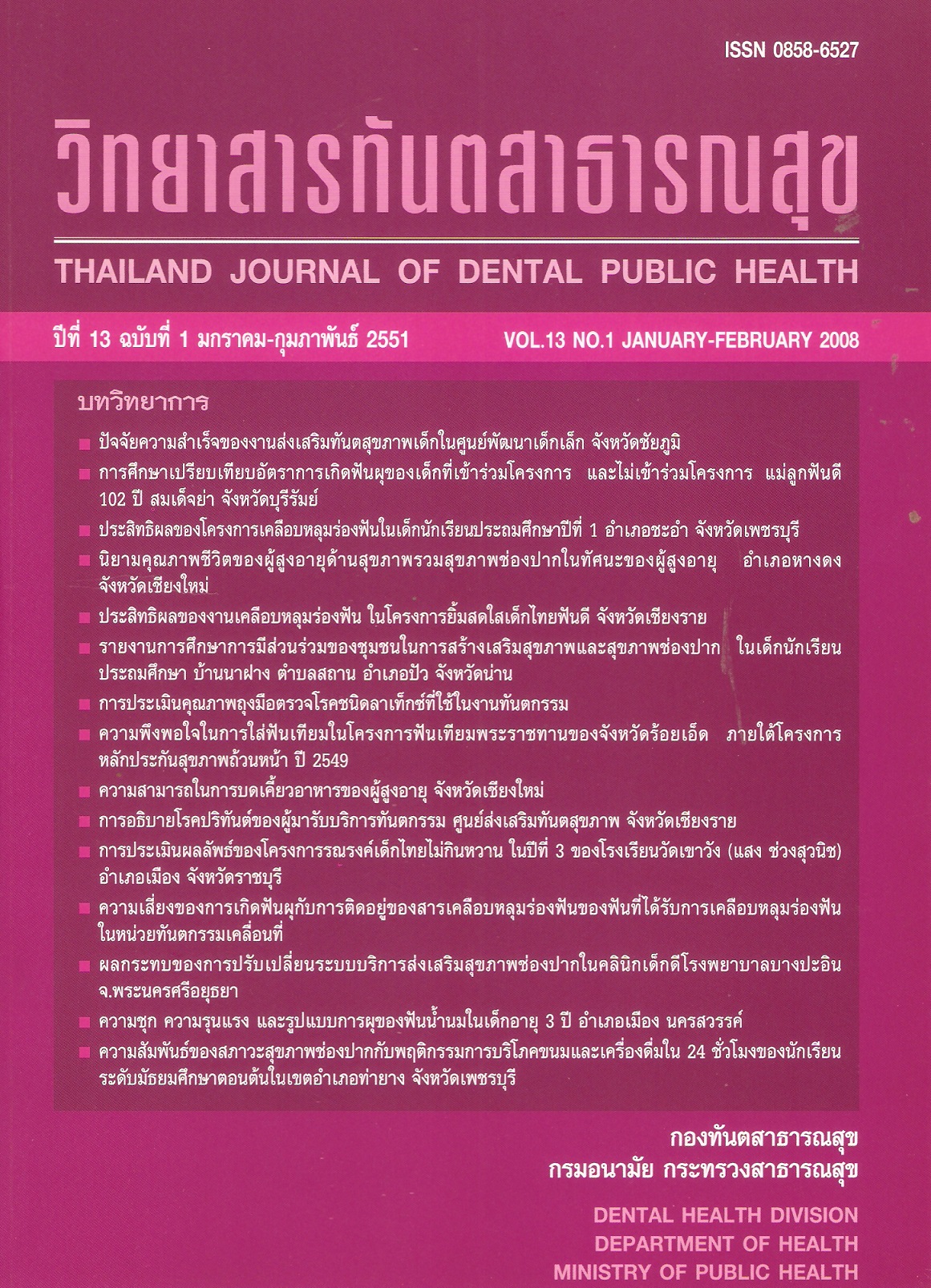Caries risk and sealant's retention among sealed teeth in mobile dental clinic.
Main Article Content
Abstract
The objective of this study was to describe relationship between caries and sealant retention. The data was collected during 2003-2005. The study design was follow - up study from the day sealant was applied by dental nurse in mobile dental unit at school. The examinations were done every 6 months over a period of 30 months among 206 first grade primary school children from 11 schools in 6 Contracting Unit of Primary care in Songkhla. The sealant retention was divided into three stages : full retention, partial retention and total loss of sealant. The result showed that the loss of sealant retention was highest in first 6 months with 32.8 %. Trend of sealant loss was decreased by time. The Percentage of sealant loss were 12.4, 13.8, 6.4 and 3.9 during the intervals 6-12, 12-18, 18-24 and 24-30 months, respectively. Caries risk of partial sealant retention teeth was 2.8 times higher than teeth with total loss of sealant. Whereas full sealant retention teeth presented 0.4 times of risk or 2.5 times of preventive effect against teeth with total loss of sealant. The result from this study was suggested an urgent need to improve effectiveness of sealant program both performance and monitoring system.
Downloads
Article Details
References
2. Cohen L.A. and Horowizt A.M. : Community-based sealant programs in the United States : results of a survey. Journal of Public Health Dentristry 1993; 53,241-245.
3. บานเย็น ศิริสกุลเวโรจน์ : การยึดติดของสารเคลือบหลุมร่องฟันที่ให้บริการในหน่วยทันตกรรมเคลื่อนที่และผลต่อการลดอัตรา การเกิดโรคฟันผุ เอกสารรายงานการวิจัย หน้า 13, 2541
4. Tianviwat S., Chukadee W., Sirisakulveroj B., Leewanant R. and Larsen M.J. : Retention of pit and fissure sealants under field conditions after nearly 2-3 years. Journal of the Dental Association of Thailand 2001;51, 115-120.
5. Going A.W. : Sealant effect on incipient caries, enamel maturation and future caries susceptibility. Journal of Dental Education 1984; 48, 35-41.
6. National Institutes of Health. : Dental sealants in the prevention of tooth decay. Journal of Education 1984 ; 48, 126-131.
7. Chestnutt I.G., Schafer F., Jacobson P.M. and Stephen K.W. : The Prevalence and effectiveness of fissure sealants in Scottish adolescents. British Dental Journal 1994; 20,125-129.
8. Poulsen S., Thylstrup A., Christensen P.F. and Ishoy U. : Evaluation of a pit and fissure- sealing program in a public dental health service after 2 years. Community Dental and Oral Epidemiology 1979 ; 7, 154-157.
9. Thipsoonthornchai J. : The comparative study on retention rate and caries prevention between Glass ionomer and Resin using as pit and fissure sealant in mobile dental service, Buriram province. Journal of Dental Public Health 2003; 15, 62-67.
10. Simonsen R.J.: Retention and effectiveness of dental sealant after 15 years. Journal of American Dental Association 1991; 122, 34-42.
11. Moller I.J. and Poulsen S.: A standardized system for diagnosting, recording and analyzing dental caries data. Scandinavia Journal of Dental Research 1973; 81, 1-13.
12. Scorino avaa Jouría gÁ (2550) : 057967979 และสมการสําหรับการวิจัยทางสุขภาพ. พิมพ์ ครั้งที่ 1 ที่กรุงเทพฯ : จุฬาลงกรณ์มหาวิทยาลัย
13. http://en.wikipedia.org/wiki/Markov_ chain (Access on 5 December 2007)
14. Gwinnette A.J.: The bonding of sealants to enamel. America Society of Preventive Dental Journal 1973, 21-2.9.
15. Feigal R.J., Hitt J. and Splieth C. : Retaining sealant on salivary contaminated enamel. Journal of American Dental Association 1993; 124,88-97.
16. Bravo M.,Osorio E., Garcia-Anllo I., Llodra J.C. and Baca P. : The influence of dft index on sealant success : a 48- month survival analysis. Journal of Dental Research 1996; 75, 768-774.
17. Holst A., Braune K. and Sullivan A. : A five - year evaluation of fissure sealants applied by dental assistants. Sweden Dental Journal 1998 ; 22, 195-201.
18. Wendt L.K., Koch G. and Birkhed D. : On the retention and effectiveness of fissure sealant in permanent molars after 15-20 years : a cohort study. Community Dental and Oral Epidemiology 2001; 29, 302-307.
19. Llodra J.C., Bravo M., Delgado-Rodriguez M., Baca P. and Galvez R. : Factors influencing the effectiveness of sealantsa meta - analysis. Community Dental and Oral Epidemiology 1993; 21, 261- 268.
20. Lussi A.: Validity of diagnostic and treatment decisions of fissure caries. Caries Research 1991 ; 25, 296-303.
21. Mertz-Fairhurst E.J., Schuster G.S. and Fairhurst C.W.: Arresting caries by sealant: results of a clinical study. Journal of American Dental Association 1986; 112,194-197.
22. Handelman S.L., Leverett D.H., Espeland M.A. and Curzon J.A.: Clinical radiographic evaluation of sealed carious and sound tooth surfaces. Journal of American Dental Association 1986 ; 113,751-754.
23. Duangthip D.,Lussi A.: Effects of application techniques and fissure types on the in vitro performance of two fissure sealants. Journal of American Dental Association 2004;17(2) , 134-142.
24. ฝ่ายทันตสาธารณสุข สํานักงานสาธารณสุข จังหวัดสงขลา : รายงานผลการสํารวจสภาวะ ทันตสุขภาพจังหวัดสงขลา ครั้งที่ 3 พ.ศ. 2544


